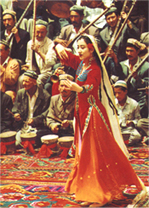| |
Hotan Region
( 2005-09-13 )
 The Hotan region, located at the southernmost part of Northwest China's Xinjiang Uygur Autonomous Region, connects with Tibet via the Karakorum and Kunlun mountains in the south and borders India and the Kashmir region in the southeast and goes deep into the heartland of the Taklimakan Desert. The Hotan region, located at the southernmost part of Northwest China's Xinjiang Uygur Autonomous Region, connects with Tibet via the Karakorum and Kunlun mountains in the south and borders India and the Kashmir region in the southeast and goes deep into the heartland of the Taklimakan Desert.
It covers an area of 248,000 square kilometers, with one city and seven counties under its administration. Hotan City, seat of the administrative agency, is 1,513 kilometers away from Urumqi via a desert road based on highway distance. The region has a total population of 1.5 million, of which the Uygurs makes up over 97%.
The region has a temperate continental arid climate. The total river runoff is 88.2 hundred million cubic meters and the exploitable underground water volume comes to 23.63 hundred million cubic meters. The natural forest area is 173,900 hectares, the man-made forest preserved area, 97,000 hectares, and the natural pastureland area, 2,501,900 hectares.
The main fruits are walnut and almond, the rare animals are wild yak, Tibet wild donkey, chiru, bharal, and snow cock, and the main medicinal plants are Chistanche salsa, Saussurea involucrate, Ephedra sinica, licorice, cynomorium songaricum, and wolfberry. The mineral resources are mainly jade, coal, salt, oil, gypsum, mica, and marble, of which jade is the most famous.
 Known as Yutian, Tian, or State of Yutian in ancient times, Hotan was one of the earliest centers of Buddhism in the Western Regions. Eminent monks such as Fa Xian and Xuan Zang (on who the Journey to the West is based on) visited it. Known as Yutian, Tian, or State of Yutian in ancient times, Hotan was one of the earliest centers of Buddhism in the Western Regions. Eminent monks such as Fa Xian and Xuan Zang (on who the Journey to the West is based on) visited it.
Once a major transport center of the southern route of the Silk Road, it is also famous for silk, jade, and carpets, hence reputed as the "home of jade," "home of silk," "capital of carpets," and "land of fruits," and so on.
The area has a long history of silkworm breeding, silk reeling, and making silk textiles, as it was once the silk center on the Silk Road. It is also famed far and wide for its production of jade and jasper, especially the pure white nephrite, opaque jade, and jade of brilliant green color.
According to historical records, Hotan was the birthplace of the famous Xinjiang carpet. In those days, Xinjiang carpets were carried through the Silk Road eastward to the Central Plains of China and westward to Central Asia and even to the Mediterranean. Their unique designs are also a mixed product of Oriental and Western cultures of the past 2,000 years.
There are many cultural relics sites, such as the ruins of Niya, Eastern Han Tombs, cliff carvings in Sangzhu, and Zam Grottoes, and so on.
|
|

